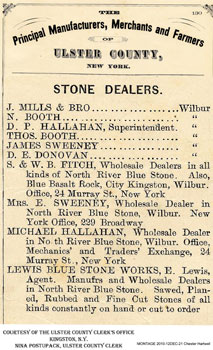Bluestone Glossary
ashlar. Describes a stone with cut edges, usually used for more formal walls and in buildings. It is usually laid in regular or broken horizontal courses. A stone may have a dressed or natural face. (ICS)
bedding plane. A geologist’s term for what bluestone workers would call a lift.
bedrock. The first layer of rock you come to when you dig through the soil on a ground surface.
blasting powder. The explosive powder used to help clear the top and provide access to stratified bluestone. (MB-91)
block. (1) A slab of stone cut into a rectangular shape. (2) The unmined bluestone that lays beneath the top (earth and other material that has to be removed to get to the block). (Evers)
bluestone. A type of sandstone that is extremely dense and is characterized by a blue-gray color. Generally very durable, dries quickly, and maintains a rough surface even with wear; therefore, relatively unslippery. (Hoffman and others)
boom. The pole on a derrick that extended out and supported cable pulleys for lifting up or loading down a load of bluestone. (Du Mond)
cap layer. The top layer of a stone that appeared to be one layer when quarried. The cap layer can sometimes be separated after the stone is removed from the quarry.
capstone. A flat coping.
cat face. A thin layer of bluestone that sometimes separates the thicker and more usable layers. (MB-91)
Catskill Sea. A body of water formed in the Devonian period when much of the Catskill plateau was covered by water. The sands deposited from rivers onto a delta or coastline of this sea gradually hardened and lithified (or were compressed) into sandstone and a special form of it called bluestone. (Titus)
coping. A stone (or other material) that sits horizontally on top of a wall or fence that has no other top and both finishes and helps to protect the top of the wall or fence. (ICS)
corporation five-foot flag. A standard size of flagstone. (MB-89)
cutting shed. A building in which raw stone is cut into standard sizes and otherwise prepared for shipment and use.
derby hat. Worn by stone-workers as the equivalent of today’s “hardhat.” (Du Mond)
Devonian. The geologic period corresponding to 345 to 405 million years ago and between the Carboniferous and Silurian periods. The age of fish and first appearance of amphibians. Named after the southwestern part of England, Devon or Devonshire where there is a red sandstone from this era. Bluestone was formed in this (actually Upper Devonian) period.
dimension stone. Stone that is cut in uniform sizes for use as building blocks. Bluestone was not considered to be much of a dimension stone although it was sometimes used as such. (Haring)
derrick. A machine, usually driven by manual or steam engine power in the 19th century, that is used to raise a weight such as a slab of bluestone. There are lifting derricks and loading derricks. (Du Mond)
dressed. Descriptive of stone that has been shaped and smoothed by sawing, planing, and rubbing. (Du Mond)
edge stone. Stone containing one side with a cut face. In the 19th century bluestone industry, commercial grade #2 was edge stone. Uses included window sills, lintels, and mantel pieces. (Haring)
end joint. A vertical breaking point in the top layer of a bed of stone, at right angles to the dip of the layer. Typically, holes are hammered on a line into this end joint to help break the stone at this point.
face. The side of a stone used in a wall or fence that presents the best appearance to a viewer or that aligns best with other stones.
face side. The side of a wall or fence that is intended to be viewed. A fence in the countryside usually has one face (the other side of the fence is rougher in terms of vertical alignment); a fence in front of a house may need to have two faces.
feather. A piece of iron, sometimes from a discarded buggy or wagon wheel, used to apply pressure in a hole when a plug was driven into the hole. Generally, a pair of feathers was inserted in the hole before the plug was hammered in. (Du Mond)
flag. 1. A sheet or layer of stone that is removed from a quarry. (MB-91)
2) Synonym for flagstone.
flagstone. Any stone that is cut as a slab thick enough to support human traffic. Commonly used in sidewalks, patios, curbstones, and for many other purposes. Commercial grade 1 in bluestone. (Haring)
flow lineation. Not easily discernable, but the characteristic in a piece of bluestone that reflects how the sands are lined up behind each other due to the primordial (?) current flow. (Titus)
goggles. Protective glasses often worn for protection by stone workers along with a derby hat. (Du Mond)
grades of bluestone. There were at least three commercial grades of bluestone: Grade 1 was flagstone which was at least one and a half inches thick and used for sidewalks. Grade 2 was edge stone, which required at least one edge of the stone to be cut for a good outward appearance, for use as window sills, lintels, mantel pieces, etc. Grade 3 was simply rock, or sized blocks for use as platforms, steps, and building blocks. (Haring)
gray sandstone. A sandstone that can be confused with bluestone because of its color that was sometimes mined for use but lacks the strength and durability of bluestone.
Graywacke. A name sometimes used by geologists for bluestone and any stone formed of heated clay. (MB-79)
holder. The stone worker who holds a drill that is used to put a hole in the top of a layer of bluestone where it is to be cut off from a ledge. Holes are placed several inches apart in a line. The holder works with a striker. (Du Mond)
hurdy-gurdy. A device in which horses walked in a circle to power a derrick. (Du Mond)
joint. A separation point in the stone. (MB-91)
jumper. The drill that, struck with a sledge hammer, put a hole in the bluestone. A row of such holes was drilled to cut off a horizontal slab of stone. (Evers) The jumper was held by a holder. (Du Mond)
ladle. A long-handled spoon used to remove the loose chips from a hole drilled into a stone. (Du Mond)
lift. Another term for a natural layer of stone. (Du Mond)
lintel. A stone that sits across the top of a door or window and helps support the wall weight above it. (ICS)
North River bluestone. The name often used to describe New York State bluestone commercially. (North River was the early name for the Hudson River.)
paver or paving stone. A uniformly-sized block of stone mainly used to form a road or street pavement. A paver must bear a heavier load than a stone used in a wall.
pea coal. Rubbage that has been crushed for use in concrete. (MB-91)
pencil rock. A very thin layer of rock that separated two thick (and hopefully usable) layers or slabs of rock. Possibly a synonym for cat rock.
planer. A tool used to create a uniformly smooth surface on a stone.
plug. A small rod of iron that was pounded into a slab at a number of points along on a line to break a slab off vertically. (Du Mond)
plug and feather wedge. The type of wedge typically used to separate a slab of bluestone from a lower layer.
potlid. A piece of bluestone that could be used to cover pots, crocks, or barrels to protect the contents. (Evers)
potlid quarry. A derogatory term for a quarry that couldn’t produce a slab of any usable size other than a potlid. (Wolven)
quarry. A place from which stone is obtained or dug. To get access to stone below the ground surface, it is often necessary to use explosives to remove earth so that access is provided to the layered stone.
quarry rent. The income royalty paid by a bluestone quarry operator to the owner of the quarry property, a common arrangement in the 19th century bluestone industry. (Hoffman)
reed. Synonym for bedding plane. (Haring)
ringdog. An iron bar with rings attached so that, when a pole is inserted through the rings, a heavy piece of stone can be levered up. (Umhey)
ripple mark. A sometimes discernable feature in bluestone that shows how the sand was rippled over time by a current flow. (Titus)
rubbage. The refuse from the quarry that is considered to be useless stone. (Du Mond, others.)
saw. A tool used to cut stone.
seam. The separation point between layers of a sedimentary stone such as bluestone. The point at which a quarryman would insert a wedge as a first step in taking off the top layer. (Du Mond, MB-91, others)
sedimentary. Layered. Rocks can be characterized in terms of how they formed: igneous (volcanic), sedimentary (formed from layered deposits), or metamorphic (a combination of igneous and sedimentary).
sill. The solid base on which something may be built such as a post-and-beam construction or a doorway threshold. Bluestone is sometimes used as a sill.
spalt. The stone chips that fly when a hammer or sledge is used to pound a drill into a stone. (Du Mond)
spalting sledge. The hammer used to pound a drill into the stone. By turning the drill, a hole can be formed. (Du Mond)
steam boiler. A machine that used steam to power a quarry or loading dock derrick.
stone boat. A flat-bottomed wood platform of four-inch planks built for dragging loads of bluestone through woods and other rough terrain pulled by a team of horses. (Du Mond, Haring)
stone slide. A path or chute from the top of a hill or mountain used to move bluestone with gravity. (Haring)
stone-cutter. A specialist in cutting stone. In 1891, a stone-cutter was paid between $3 and $5 a day. (MB-91)
striker. The stone worker who strikes a drill with a hammer called a spalting sledge to put a series of holes in a line across a layer of stone. The striker works with a holder. (Du Mond)
stripping. The work of removing the top soil and other matter above the usable stone. (MB-91)
tailings. Synonym for rubbage. (Du Mond, others)
teamster. Wagon driver.
the top. The soil or rock above a solid ledge of stone that must be removed before usable stone can be quarried. (MB-91, others)
tobacco. Quarrymen are said to have chewed tobacco as a way to keep their throats from getting too dry with bluestone dust. (Evers)
tramway. A synonym for the track of bluestone that was laid to speed delivery between quarries and loading dock (MB-91)
wedge. A thin iron rod hammered into a seam or lift in the stone to help separate it from the layer of rock underneath. (Evers)


SOURCES:
Du Mond, Frank L. Walking Through Yesterday in Old West Hurley. 1990.
Evers, Alf. The Catskills – From Wilderness to Woodstock. 1972.
Haring, H. A. Our Catskill Mountains. 1931.
Hoffman, A. W. “Ulster County Bluestone.” R. Lionel De Lisser, Picturesque Ulster. 1896.
ICS. I.C.S. Reference Library – Masonry. 1904.
MB-79. Author not identified. “Our Bluestone Sidewalks.” The Manufacturer and Builder, October 1879.
MB-89. Author not identified. “Hudson River Bluestone.” The Manufacturer and Builder, June, 1889.
MB-91. Author not identified. “Bluestone Sidewalks.” The Manufacturer and Builder, April, 1891.
Umhey, Kevin. Interviews with Kevin Umhey, September 2003.
Wolven, Francis. Interview with Francis Wolven, September 2003.
Compiled September 2003.
